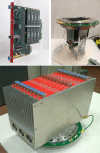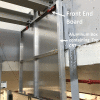ICARUS at the Fermilab Short-Baseline Neutrino program: initial operation
- PMID: 37303462
- PMCID: PMC10239613
- DOI: 10.1140/epjc/s10052-023-11610-y
ICARUS at the Fermilab Short-Baseline Neutrino program: initial operation
Abstract
The ICARUS collaboration employed the 760-ton T600 detector in a successful 3-year physics run at the underground LNGS laboratory, performing a sensitive search for LSND-like anomalous appearance in the CERN Neutrino to Gran Sasso beam, which contributed to the constraints on the allowed neutrino oscillation parameters to a narrow region around 1 eV. After a significant overhaul at CERN, the T600 detector has been installed at Fermilab. In 2020 the cryogenic commissioning began with detector cool down, liquid argon filling and recirculation. ICARUS then started its operations collecting the first neutrino events from the booster neutrino beam (BNB) and the Neutrinos at the Main Injector (NuMI) beam off-axis, which were used to test the ICARUS event selection, reconstruction and analysis algorithms. ICARUS successfully completed its commissioning phase in June 2022. The first goal of the ICARUS data taking will be a study to either confirm or refute the claim by Neutrino-4 short-baseline reactor experiment. ICARUS will also perform measurement of neutrino cross sections with the NuMI beam and several Beyond Standard Model searches. After the first year of operations, ICARUS will search for evidence of sterile neutrinos jointly with the Short-Baseline Near Detector, within the Short-Baseline Neutrino program. In this paper, the main activities carried out during the overhauling and installation phases are highlighted. Preliminary technical results from the ICARUS commissioning data with the BNB and NuMI beams are presented both in terms of performance of all ICARUS subsystems and of capability to select and reconstruct neutrino events.
© The Author(s) 2023.
Figures



































References
-
- C. Rubbia, The liquid argon time projection chamber: a new concept for neutrino detectors. CERN-EP 77–08 (1977)
-
- A.A. Aguilar-Arevalo et al. (LSND Collaboration), Evidence for neutrino oscillations from the observation of electron anti-neutrinos in a muon anti-neutrino beam. Phys. Rev. D 64, 112007 (2001)
-
- A.A. Aguilar-Arevalo et al. (MiniBooNE Collaboration), Updated MiniBooNE neutrino oscillation results with increased data and new background studies. Phys. Rev. D 103, 052002 (2021)
-
- M. Antonello et al. (ICARUS Collaboration), Search for anomalies in the appearance from a beam. Eur. Phys. J. C 73, 2599 (2013)
-
- R. Acciarri et al. (SBND-MicroBooNE-ICARUS Collaborations), A proposal for a three detector short-baseline neutrino oscillation program in the Fermilab booster neutrino beam (2015). arXiv:1503.01520
LinkOut - more resources
Full Text Sources
